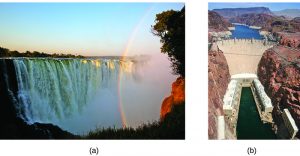Introduction to Energy
Energy is a vital component of the world around us. Nearly every physical and chemical process, including all processes discussed in previous chapters, occurs with a simultaneous energy change. Chemical reactions, such as those that occur when you light a match or bake cookies, involve changes in energy as well as matter. Physical changes involves changes in energy as well, such as boiling water or freezing water to form ice cubes. In this chapter, we will explore the nature of energy and how energy and chemistry are related to food and cooking.

Chemical changes and their accompanying changes in energy are important parts of food and cooking (Figure 5.2). The macronutrients in food (proteins, fats, and carbohydrates) undergo metabolic reactions that provide the energy to keep our bodies functioning. We burn a variety of fuels (gasoline, natural gas, coal) to produce energy and electricity for cooking foods in our kitchens, heating our homes, and transportation around our cities. Industrial chemical reactions use enormous amounts of energy to produce raw materials (such as iron and aluminum). Energy is then used to manufacture those raw materials into useful products, such as cast-iron cookware and aluminum foil.

Over 90% of the energy we use comes originally from the sun. Plants capture solar energy through photosynthesis. We use this energy to fuel our bodies by eating plant-based food or food from animal sources that got their energy by eating plants. Burning coal and petroleum also releases stored solar energy: These fuels are fossilized plant and animal matter.
Types of Energy
Energy, another important quantity in chemistry, is the ability to supply heat or perform work, such as moving a box of books from one side of a room to the other side. You can understand what this means by thinking about yourself when you feel “energetic.” You feel ready to go—to jump up and get something done. When you have a lot of energy, you can perform a lot of work. By contrast, if you do not feel energetic, you have very little desire to do much of anything. This description is not only applicable to you but also to all physical and chemical processes. The quantity of work that can be done is related to the quantity of energy available to do it.
Like matter, energy comes in different types. One scheme classifies energy into two types:
- potential energy: the energy an object has because of its relative position, composition, or condition
- kinetic energy: the energy that an object possesses because of its motion
Water at the top of a waterfall or dam has potential energy because of its position; when it flows downward through generators, it has kinetic energy that can be used to do work and produce electricity in a hydroelectric plant. A battery has potential energy because the chemicals within it can produce electricity that can do work.

Energy can be converted from one form into another, but all of the energy present before a change occurs always exists in some form after the change is completed. This observation is expressed in the law of conservation of energy: during a chemical or physical change, energy can be neither created nor destroyed, although it can be changed in form.
When one substance is converted into another, there is always an associated conversion of one form of energy into another. Heat is usually released or absorbed, but sometimes the conversion involves light, electrical energy, or some other form of energy. For example, chemical energy (a type of potential energy) is stored in the molecules that compose gasoline. When gasoline is combusted within the cylinders of a car’s engine, the rapidly expanding gaseous products of this chemical reaction generate mechanical energy (a type of kinetic energy) when they move the cylinders’ pistons.
Click on the PhET simulation to explore energy forms and changes. Visit the Energy Systems tab to create combinations of energy sources, transformation methods, and outputs. Click on Energy Symbols to visualize the transfer of energy.
Attributions
This page is based on “Chemistry 2e” by Paul Flowers, Klaus Theopold, Richard Langley, William R. Robinson, PhD, Openstax which is licensed under CC BY 4.0. Access for free at https://openstax.org/books/chemistry-2e/pages/1-introduction
This page is based on “The Basics of General, Organic, and Biological Chemistry” by David W Ball, John W Hill, Rhonda J Scott, Saylor which is licensed under CC BY-NC-SA 4.0. Access for free at http://saylordotorg.github.io/text_the-basics-of-general-organic-and-biological-chemistry/index.html

